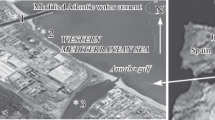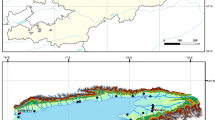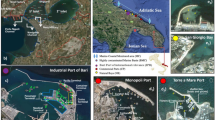Abstract
Yongding New River has been polluted by polycyclic aromatic hydrocarbons (PAHs) which are carcinogenic and mutagenic. In three periods (the abundant water period, mean water period, dry water period), ten sites (totally 30 samples) in Yongding New River were clustered into four categories by hierarchical cluster analysis (hierarchical CA). In the same cluster, the samples had the same approximate contamination situation. In order to eliminate the dimensional differences, the data in each sample, containing 16 kinds of PAHs, were standardized with normal standardization and maximum difference standardization. According to the results of the cubic clustering criterion, pseudo F, and pseudo t 2 (PST2), the proper number of clustering for the 30 samples is 4. Before conducting hierarchical CA and K-means cluster analysis on the samples, we used principal component analysis to obtain another group data set. This data set was composed of the principal component scores which are uncorrelated variables. Hierarchical CA and K-means cluster analysis were used to classify the two data sets into four categories. With the classification results of hierarchical CA and K-means cluster analysis, discriminant analysis is applied to determine which method was better for normalization of the original data and which one was proper to cluster the samples and establish discriminant functions so that a new sample can be grouped into the right categories.


Similar content being viewed by others
References
ATSDR (1995). Toxicology profile for polyaromatic hydrocarbons. Atlanta, GA: U.S. Department of Health and Human Services. http://www.atsdr.cdc.gov/toxprofiles/tp69-p.pdf. Accessed 8 Aug 1995.
Bostrom, C., Gerde, P., Hanberg, A., Jernstrom, B., Johansson, C., Kyrklund, T., Westerholm, R. (2002). Cancer risk assessment, indicators, and guidelines for polycyclic aromatic hydrocarbons in the ambient air. Environmental Health Perspectives, 3, 451–488.
Commission, E. (2011). Opinion of the Scientific Committee on Food on the risks to human health of polycyclic aromatic hydrocarbons in food. http://eceuropaeu/food/fs/sc/scf/out153-enpdf. Accessed 5 June 2011.
Elliot, R., Singhal, N., Swift, S. (2010). Surfactants and bacterial bioremediation of polycyclic aromatic hydrocarbon contaminated soil-unlocking the targets. Critical Reviews in Environmental Science and Technology, 41(1), 78–124.
Guo, J.P., Li, W.H., et al. (2012). Standardization of interval symbolic data based on the empirical descriptive statistics. Computational statistics and data analysis, 56, 602–610.
Guo, J.Y., Liang, Z., Liao, H.Q., Tang, Z., Zhao, X.L., Wu, F.C. (2011). Sedimentary record of polycyclic aromatic hydrocarbons in Lake Erhai, Southwest China. Journal of Environmental Sciences, 23(8), 1308–1315.
Hao, R., Wan, H.F., Song, Y.T., Jiang, H., Peng, S.L. (2007). Polycyclic aromatic hydrocarbons in agricultural soils of the southern subtropics, China. Pedosphere, 17, 673–680.
Hayal, B., & Hiilya, B. (2010). Detection of seasonal variations in surface water quality using discriminant analysis. Enviromental Monitoring and Assessment, 162, 15–20.
Jung, K.H., Kim, J.K., Noh, J.H., Eun, J.W., Bae, H.J., Kim, M.G., Chang, Y.G., Shen, Q., Kim, S.J., Kwonc, S.H., Park, W.S., Lee, J.Y., Nam, S.W. (2013). Characteristic molecular signature for the early detection and prediction of polycyclic aromatic hydrocarbons in rat liver. Toxicology Letters, 216, 1–8.
Kamble, S.R., & Vijay, R. (2011). Assessment of water quality using cluster analysis in coastal region of Mumbai, India. Environmental Monitoring and Assessment, 178, 321–332.
Lewtas, J. (2007). Air pollution combustion emissions: characterization of causative agents and mechanisms associated with cancer, reproductive, and cardiovascular effects. Mutation Research/Reviews in Mutation Research, 636, 95–133.
Lu, W.X., Li, J., Yu, F.R., Yu, G.Q., Liu, L. (2009). Application of stepwise discriminant analytical method in screening factor in the water quality evaluation. Journal of Jilin University(Earth Science Edition), 39(1), 126–130.
Menzie, C.A., Potocki, B.B., Santodonato, J. (1992). Exposure to carcinogenic PAHs in the environment. Environmental Science and Technology, 26, 1278– 1284.
Mirsadeghi, S.A., Zakaria, M.P., Yap, C.K., Shahbazi, A. (2011). Risk assessment for the daily intake of polycyclic aromatic hydrocarbons from the ingestion of cockle (Anadara granosa) and exposure to contaminated water and sediments along the west coast of Peninsular Malaysia. Journal of Environmental Sciences, 23(2), 336–345.
Montuori, P., & Triassi, M. (2012). Polycyclic aromatic hydrocarbons loads into the Mediterranean Sea: estimate of Sarno River inputs. Marine Pollution Bulletin, 64, 512–520.
Neff, J.M. (1979). Polycyclic aromatic hydrocarbons in the aquatic environment: sources, fates and biological effects. London: Applied Science Publishers.
Papaioannou, A., Mavridou, A., Hadjichristodoulou, C., Papastergiou, P., Pappa, O., Dovriki, E., Rigas, I. (2010). Application of multivariate statistical methods for groundwater physicochemical and biological quality assessment in the context of public health. Environmental Monitoring and Assessment, 170, 87–97.
Ravindra, K., Sokhi, R., Grieken, R.V. (2008). Atmospheric polycyclic aromatic hydrocarbons: source attribution, emission factors and regulation. Atmospheric Environment, 42, 2895–2921.
Shrestha, S., Kazama, F., Nakamura, T. (2008). Use of principal component analysis,factor analysis and discriminant analysis to evaluate spatial and temporal variations in water quality of the Mekong River. Journal of Hydroinformatics, 10, 43–56.
Soclo, H., Budzinski, H., Garrigues, P., Matsuzawa, S. (2008). Biota accumulation of polycyclic aromatic hydrocarbons in Benin coastal waters. Polycyclic Aromatic Compounds, 28, 112–127.
Tremolada, P., Burnett, V., et al. (1996). Spatial distribution of PAHs in the U.K. atmosphere using pine needles. Journal of Environmental Science and Technology, 30(12), 3570–3577.
Wang, Z.C., et al. (2012). Distribution of PAHs in tissues of wetland plants and the surrounding sediments in the Chongming Wetland, Shanghai, China. Chemosphere, 89, 221–227.
Wilcke, W. (2000). Polycyclic aromatic hydrocarbons (PAHs) in soil—a review. Journal of Plant Nutrition and Soil Science, 163, 229–248.
Wild, S.R., & Jones, K. (1995). Polycyclic aromatic hydrocarbons in the UK environment: a preliminary source inventory and budget. Environmental Pollution, 88, 91–108.
Wu, B., Zhang, Y., Zhang, X.X., Cheng, S.P. (2011a). Health risk assessment of polycyclic aromatic hydrocarbons in the source water and drinking water of China: quantitative analysis based on published monitoring data. Science of the Total Environment, 410–411, 112–118.
Wu, Y.L., Wang, X.H., Li, Y.Y., Hong, H.S. (2011b). Occurrence of polycyclic aromatic hydrocarbons (PAHs) in seawater from the Western Taiwan Strait, China. Marine Pollution Bulletin, 63, 459–463.
Xin, X., Lu, W.X., Gong, L. (2008). Discriminant analysis method application in water quality assessment. Environmental Science and Technology, 31, 113–115.
Zhang, K., Liang, B., Wang, J.Z., Guan, Y.F., Zeng, E.Y. (2012). Polycyclic aromatic hydrocarbons in upstream riverine runoff of the Pearl River Delta, China: an assessment of regional input sources. Environmental Pollution, 167, 78–84.
Acknowledgement
This work was supported by the National Natural Science Foundation of China (no. 51178018 and no. 71031001).
Author information
Authors and Affiliations
Corresponding author
Rights and permissions
About this article
Cite this article
Wang, X., Zou, Z. & Zou, H. Using discriminant analysis to assess polycyclic aromatic hydrocarbons contamination in Yongding New River. Environ Monit Assess 185, 8547–8555 (2013). https://doi.org/10.1007/s10661-013-3194-3
Received:
Accepted:
Published:
Issue Date:
DOI: https://doi.org/10.1007/s10661-013-3194-3




